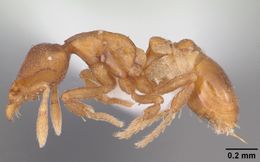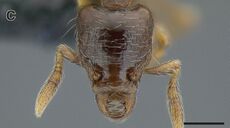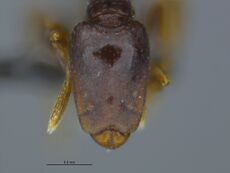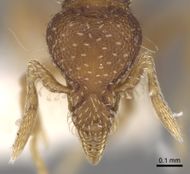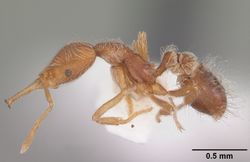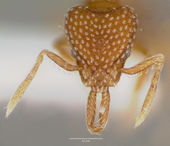Key to Strumigenys of Hispaniola
This worker key is based on: Booher, D.B., Prebus, M.M., Lubertazzi, D. 2019. A taxonomic revision of the Strumigenys nitens and simulans groups (Hymenoptera: Formicidae), two Caribbean radiations of leaf litter ants. Zootaxa 4656, 335-358 (doi:10.11646/zootaxa.4656.2.7).
The Hispaniola ant fauna consists of eleven species.
Booher et al. (2019) – Strumigenys does not show a high degree of endemism in the Caribbean. There are seven species belonging to two species groups, with both being exclusively Caribbean endemics (simulans and nitens groups). The eighth species is a Jamaican species, Strumigenys jamaicensis, from the neotropical gundlachi species group.
The discovery of S. zemi and S. economoi on Hispaniola raises the number of Strumigenys species on the island to eleven. The nine previously known species includes a group of six broadly distributed Neotropical species and three pan-tropical tramp species.
There have been only a small number of specimens collected for all the endemic Caribbean Strumigenys. Unlike the more abundantly encountered non-endemic members of this genus, the low number of specimens collected suggests these ants are either rare or poorly sampled. In terms of rarity, it is possible this was not true in the past. Strumigenys zemi was sampled in numerous Winkler samples within a relatively small area, and two workers were subsequently hand collected further west of the preserve where the types were collected. Both locations are some of the better-preserved natural areas in the Cordillera Septentrional. If this species, and all of the ants in these two species groups, are dependent on fairly well-preserved native habitat it is possible they have now become rare due to the pervasive habitat degradation or outright land conversion found across the Caribbean. As for sampling intensity, it is clear that most species in the genus Strumigenys were, and remain, poorly represented in hand collected samples. The more widespread adoption of litter sampling has been vital in revealing the remarkable diversity of this genus throughout the world's tropical and subtropical regions. The collection records of all the Caribbean endemics show the majority of specimen are from passively extracted litter collections, i.e., Berlese and Winkler samples. Prior to 2015, we are not aware of not aware of any Winkler sampling occurring on Hispaniola. Previous ant collectors may have casually searched the litter by hand or utilized a few portable Berlese funnels, but even if searching of the litter was done it was limited in its extent. More expansive litter sampling across Hispaniola, and the larger islands of the Caribbean overall, will help better understand the distribution and abundance of these ants, and potentially reveal additional species.
You may also be interested in
1
- Dorsum of pronotum without sculpture . . . . . 2
- Dorsum of pronotum variously sculptured, at least some striations or punctuation evident in either dorsal or lateral view . . . . . 4
2
return to couplet #1
- Dorsum of head smooth and shining medially and posteriorly; propodeal spines present; darker brown species . . . . . 3
- Dorsum of head heavily punctate over entire surface; propodeum without spines; dull and light orange . . . . . Strumigenys membranifera
3
return to couplet #2
- Mandibular teeth elongate and spiniform with first two teeth not overlapping or interlocking when shut . . . . . Strumigenys zemi
- Mandibles with small, conical, serially dentate teeth that interlock when shut . . . . . Strumigenys economoi
4
return to couplet #1
- In full face view mandibles shorter (MI ≤ 25), with a series of alternating, bluntly rounded, triangular teeth that interlock in closed position; outline of mandibles triangular . . . . . Strumigenys nigrescens
- In full face view mandibles longer (MI ≥ 26 and usually much longer, MI >50), meeting only at the distal tip, never with a basal series of interlocking teeth in closed position; outline of mandibles not triangular . . . . . 5
5
return to couplet #4
- Antenna with 4 segments; in full face view mandibles strongly convex, bow-like, with a single pair of long spiniform teeth, just distal to midpoint of mandible, that are much longer than the maximum width of mandible; mandibles relatively short (MI ≤ 40). In full frontal view, entire dorsal surface of head and anterior margin of scape with apically expanded, orbicular setae . . . . . Strumigenys emmae
- Antenna with 6 segments; In full face view mandibles elongate (MI > 50), linear, and not bow-like; without spiniform teeth near midpoint of mandible; setae on head and scape fine to spoon-shaped, but never orbicular . . . . . 6
6
return to couplet #5
- Petiole, postpetiole, and gaster with abundant, long, filiform to flagellate setae; absent of shorter laterally expanded clavate setae; dorsal margin of antennal scrobe with two long flagellate setae, one at mid-scrobal position just above the compound eye and another at apicoscrobal position . . . . . Strumigenys lanuginosa
- Erect setae, when present on the petiole, postpetiole, or gaster, are short and stiff and/or laterally expanded, never flagellate; erect scrobal setae, when present, are limited to a single pair of clavate to flagellate setae in apicoscrobal position . . . . . 7
7
return to couplet #6
- Setae on leading edge of scape all curve away from the base of the scape; petiole with ventral spongiform tissue; mandibles with two preapical teeth arising in the distal third of mandibles and subequal in length to the width of the mandibles at the point at which they arise . . . . . Strumigenys rogeri
- Setae on leading edge of scape with one to many setae that curve toward the base of the scape; petiole without ventral spongiform tissue; if more than one preapical tooth or denticle is present, they never approach the width of mandibles where they arise . . . . . 8
8
return to couplet #7
- Entire surface of first gastral tergite punctate to reticulopunctate; postpetiole in profile with the ventral spongiform lobe absent or reduced to a minute nonspongiform vestige and without lateral flange of spongiform tissue . . . . . Strumigenys eggersi
- Surface of first gastral tergite without punctate sculpture, or if present, punctate sculpture is limited to the anterior margin; postpetiole in profile with ventral and lateral spongiform tissue present . . . . . 9
9
return to couplet #8
- Dorsum of head covered with broadly spatulate to spoon-shaped setae; mandibles with a single preapical tooth arising just anterior of apical tooth; without denticles . . . . . Strumigenys louisianae
- In full face view, setae present across anterior portion of the head and leading edge of scape are curved and flattened or expanded apically, but are not spatulate or spoon shaped; mandibles with at least two preapical teeth or denticles on the distal halves of mandibles . . . . . 10
10
return to couplet #9
- In full face view, mandibles long with linear to slightly concave outer margin; distal half of mandibles with 4-9 preapical teeth (may be difficult to see); eye larger, usually with 5-6 ommatidia . . . . . Strumigenys gundlachi
- In full face view, mandibles long and noticeably convex along their outer margin; two preapical teeth present, one near the midpoint of mandibles and one positioned just anterior the dorsoapical tooth; eye small usually with 4 or less ommatidia . . . . . Strumigenys silvestrii

